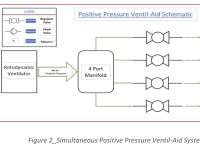
Coronavirus (COVID-19) is an illness caused by a virus that can spread from person to person and has spread throughout the world. The illness caused by the coronavirus starts with particles from an infected person’s cough, sneeze, or breath. These particles could be in the air or (aerosolized) on a surface a person touches before touching their eyes, nose, or mouth, which allows the virus a passage to the mucous membranes in a person’s throat. Within approximately 14 days of being infected, the person starts displaying symptoms such as a sore throat, a fever, or a dry cough. The coronavirus then moves down the person’s respiratory tract, eventually reaching the lungs. This causes the lungs to become inflamed, making it hard for a person to breathe which eventually leads to pneumonia, shortness of breath, and/or acute respiratory distress syndrome (ARDS). ARDS damages the tissues and tiny air sacs in the lungs, causing debris inside of them, making it hard or even impossible for a person to breathe.
Many people who get ARDS will need help from a machine called a ventilator. A ventilator is a potentially life-saving machine that helps a person breathe if they cannot do it on their own. Ventilators are important in treating COVID-19 patients helping them breathe by avoiding airway inflammation which can, in turn, lead to drowning the lungs in fluids. It was clear in the early stages during the development of the COVID-19 pandemic that a critical need in the coming months would be for ventilators. As a result of the shortage of such units as well as their eventual broader application to other clinical cases, Florida International University Faculty, Staff and Students decided to work together and develop an inexpensive 3D printed alternative, called “Positive Pressure Ventil-Aid”. The goal of this proposed research is to a rotodynamic ventilator along with mechanical components that can be produced quickly enough to make a difference in the immediate crisis, while providing a low-cost approach to ventilator manufacturing.
The “Positive Pressure Ventil-Aid” consists of a simple system that includes four main components:
- a Rotodynamic Ventilator (Figure 1),
- a Check Valve,
- a Fluid Regulator Valve
- a Manifold. The critical part of this design is the rotodynamic ventilator, based upon previous fluid dynamic research developed and reported last April 2018, through: US Patent: “Aerodynamics Mitigation and Power System (AMPS)” patent number: US 9,951,752 B2.
A schematic of the positive pressure Ventil-Aid system is shown in Figure 2. The first component attached to the rotodynamic ventilator is a manifold. The manifold is just a fluid splitter with one main entrance and four exits, which allows to maximize one fluid ventilator up to four patients or more depending on the volumetric flow and pressure characteristics of the rotodynamic ventilator. This simple idea (please see video) will allow maximizing all the resources in terms of the number of "Fluid Ventilators" available, since one Fluid-Ventilator could easily feed in parallel several patients at the same time.
Video
-
Awards
-
 2020 Top 10 Most Popular
2020 Top 10 Most Popular
Like this entry?
-
About the Entrant
- Name:Andres Tremante
- Type of entry:teamTeam members:Cristobal Galjuf, Giusseppe Bianco, Richard Zicarelli, Dimitris Pavlidis, John Volakis and Andres Tremante
- Software used for this entry:SolidWorks and ANSYS
- Patent status:patented





